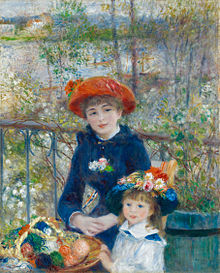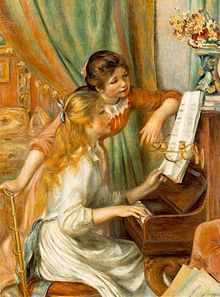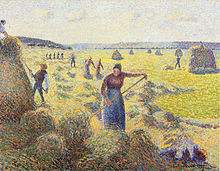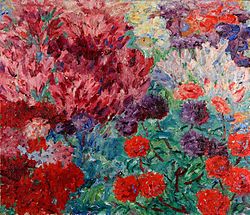IMPRESSIONISM AND EXPRESSIONISM
Impressionism painting portrays the effects of experience upon the consciousness of the artist and the audience.
The artist is characterized as one concern more with the technique of suggesting light and color to the picture than with the subject matter.
This is French and thoroughly French. In 1874, these artist were calling themselves “Impressionist” a term taken from a composition called “Impression: Rising Sun” Leaders of the movement were Claude Monet (1840-1926) who concentrated on
landscape depicting sunlight playing on water or on the carve facade of a cathedral.
Auguste Renoir (1841-1919)
who like to paint human figures, especially women, glowing with vitality and health. 

Camille Pissarro (1830-1903)
who was called the “Village Impressionist” because he painted peasant scenes.
Genges Seurat (1859-1891)
carried the technique a step further by painting an entire composition out of a tiny dots of pure color, suggesting mass and receding space by varying the intensity of the color. Critics called this “Pointilism”
Expressionism has its roots in Germany during the 20th century. The terms that characterized
this type of pointing are “harsh,” “brutal,” introspective,” and “morbid” The emotional expressions in this paintings could be described as involving pathos, morbidity, violence or chaos, and tragedy. It sometimes portrays defeat.These strong emotions seem to be the pathways through which their counterparts, joy and happiness, will come to pass.
Vincent
Van Gogh
painted the “Starry Night” which depicts his violence and subjective attitude which is the feature of Expressionism.
He expressed the turbulent spirit in strong color and twisting forms which announces the birth of a peaceful atmosphere as calmness follows a storm.
Ernest
Ludiurg Kirchner
(1880-1938) is a German expressionist who portrayed his emotion and experience with large, simple forms and clear colors.
His painting “Street” conveys the emotional state of a German city following World War I. Defeat and sickening show of rage and fear are everywhere apparent in his painting.
Emil Nolde (1867-1956)
showed bold strong colors: yellow-orange, blue-green, red-violet which are considered ugly colors for the painter.
His works include “Christ and the children,” and “St. Simeon and the Woman” where the faces of the people look like masks.
Among the famous American expressionists are Max Weber and Ivan Albright. Weber’s “Tranquility”
utilizes dark and rich colors and the forms are distorted.
Albright’s painting exudes brutality and vulgarity, like the Into the World came a Soul Name Ida” The picture implies social indictment.














